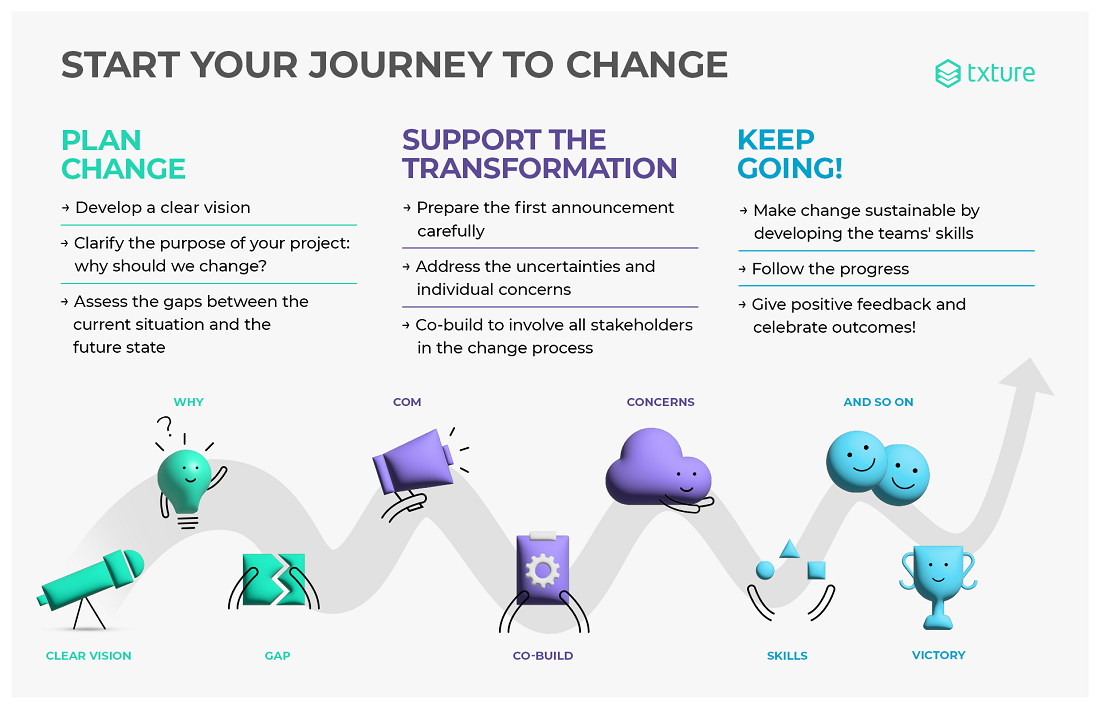5 key principles of change management to lead your team through a cloud transformation

In the fast moving IT world, organizations are under increasing pressure to keep their IT estate up-to-date. As innovation is ramping up, what is considered a cutting-edge technology today might quickly be overtaken, and become a legacy system in less than a decade.
In this context, one of the main challenges for organizations is to continually modernize their IT infrastructure, identify outdated applications and make the right modernization choices.
But an equally important challenge is to keep people motivated and aligned with the modernization choices of their organization. Indeed, while regular modernization initiatives are necessary to stay competitive and agile, it also leads to a situation where teams are asked to embrace a “new normal” every two or three years. While the IT department is directly at the forefront of change in this context, cloud transformation and cloud modernization initiatives have direct implications for every team in the organization.
One key condition to success is therefore to keep everyone committed to the modernization strategy of the organization.
 A quick overview of what the journey to change looks like!
A quick overview of what the journey to change looks like!
No one likes the change
This might sound like an exaggerated statement, and it probably is, as some people are more comfortable with change than others. But actually, even if you are the most avid advocate for change, part of you is probably more comfortable with the status quo. This is because change, even when perceived as positive, is a source of stress, as it forces us to leave our comfortable habits and move towards a partially unknown future.
From an organizational perspective, it means that moving to the cloud can generate some resistance among the employees, even from those who perceive cloud transformation as positive. Resistance to change can intensify, for instance, because of unclear communication, leading to fear and uncertainty of what the future situation will look like.
It is thus in the best interest of cloud transformation sponsors to closely accompany people before, during and after the transformation, in order to deal with people’s uncertainties, foster their willingness to change, and make the whole project a success.
5 key principles of change management
The topic of change management is quite broad. If you are looking for a complete overview, you can have a look at our dedicated whitepaper. In this article, we tried to sum up the five key principles of change management you should consider when implementing a cloud transformation.
1 - Introduce the change with a clear and precise communication
Why should I do that?
Uncertainty is one of the main causes of resistance to change. Depending on your context, you can make the first announcement in many different ways. But it should be:
- Straightforward. For example, it is better to announce a 5% reduction in costs than a “search for improving productivity”. A vague communication will open the door to open interpretations and misunderstandings.
- Honest. During a change, another motivation factor is the trust towards the change sponsors. Of course, it’s tempting to minimize the impact of the upcoming change, to alleviate negative reactions. But this is a wrong approach, as when people will realize that you did not tell everything, trust will be completely undermined.

How does it apply to cloud transformation?
Cloud Transformation is an evolution that spans the entire organization, which means it will be perceived as overwhelming.
A good way to rein in the uncertainty is to clarify the scope of the transformation. You will probably not move your whole IT infrastructure at once, and plan successive migration waves instead. Be clear on which subset of applications will be impacted first.
Also, if you worked on cloud “pilot projects”, make sure to advertise them. Change is less scary if tangible examples of successful implementations already exist in the organization.
2 - Define the purpose of change
Why should I do that?
People will react more negatively to change if they perceive it as harming, or at least if the outcomes are unpredictable. Before even going into the details of the upcoming change, you must clarify the merits of this initiative. This is a pre-requisite for engaging the teams. Your early communication should cover the following:
- Why is change needed? What will happen if we stick to the status quo?
- Why is change beneficial? Which positive outcomes will be achieved through it?
- What will be the individual benefits? What is in there for everyone, at a personal level?
How does it apply to cloud transformation?
As an advocate of cloud transformation, you had the time to read all about the benefits of cloud computing, you are aware of the necessity to continually modernize IT applications.
However, you should not assume that everyone is on the same page. People will not take what you say at face value, especially if they are satisfied with the current IT system. Thus, you should have very clear arguments on:
- Why the current IT infrastructure needs to be modernized. You can also have an opposite reasoning: what will be the outcome if the legacy system is kept as is? (For instance: a threat to be overtaken by competitors who are already leveraging the cloud).
- Why cloud computing is a relevant solution. Some of the employees will agree that modernization is needed, but might disagree with your modernization approach. You should then be very clear on which kind of cloud infrastructure is considered, and why!
3 - Involve people early on in the implementation process
Why should I do that?
The teams will be more motivated if they can have an influence on the change process. Although you should be clear on what is already decided, you should also give as much leeway as possible on how the solution will be implemented.
Co-building is a powerful motivation factor, as long as it goes beyond words! Make sure that the team leads play along and actually free up some time in the week for their team members to work on the upcoming transformation.

How does it apply to cloud transformation?
In addition to facilitating team engagement, co-building is also a logical approach. Employees have knowledge of the current situation (which technologies are used? Which applications need to be modernized as a priority?). They are in the best position to recommend the best approach to implement the transformation.
Best practices to involve people early on in the context of cloud transformation are to:
- Develop a Cloud Center of Excellence (CCoE). A CCoE is now an imperative for organizations to develop a well-thought-out cloud transformation and modernization strategy. This CCoE should involve people from different teams in the organization.
- Work on a few business cases. Pick a subset of applications and consider several replacement options in the cloud. By working on these business cases, you will involve all stakeholders upfront. You will also be able to provide concrete answers to all teams on a variety of topics such as: pricing in the cloud, compliance, sustainability, etc.
4 - Develop the skill-set of the teams
Why should I do that?
There is no magic! If new skills are needed to make the project happen, you need to identify them and act accordingly. Skill development is also one of the most powerful ways to increase the motivation of the team. In a context of change, resistance sometimes comes from a fear of failure. The transformation is perceived as too challenging. A proper training will help people to embrace the future situation with more confidence.
Skills include of course hard skills, but in a context of change, you should not overlook the soft skills: for instance, the ability to learn new things regularly, and to adapt to new situations and environments.
How does it apply to cloud transformation?
In the context of cloud transformation, one valuable approach is to develop two distinct levels of training.
- An introductory training for a large number of people in the organization. This type of training is useful for people who are not directly involved in the project, but who have an interest in knowing the basics of the subject. It will help evangelize a maximum of people and make them aware of the benefits of cloud computing.
- An expert continuous training for members of the Cloud Center of Excellence, to stay up-to-date with the latest developments in cloud computing, and gain insights into continuous IT modernization.
5 - Celebrate success when it comes!
There is no need for a long statement about this last one. Suffice it to say: cloud transformation, as any significant organizational change, is a long journey, fraught with uncertainties and obstacles. So, do not forget to celebrate the big and small victories along the way!
Key Takeaways
Wrapping it up, the process of modernizing IT infrastructure, particularly through cloud transformation, comes with both technical and psychological challenges for organizations. While the technical aspects are crucial, it is equally important to address the psychological, human element to ensure successful implementation. Organizations must understand that change, even if generally perceived as positive, can create resistance, uncertainty and even fear among employees. Therefore, effective change management is necessary to keep everyone committed to the modernization strategy. The five key principles discussed:
✅ clear and precise communication
✅ defining the purpose of the change
✅ involving people early on
✅ developing the skill-set of the teams
✅ celebrating success
provide a framework for navigating the challenges associated with cloud transformation. By following these principles, organizations can drive openness to change, alleviate resistance, and make the transition to the cloud a successful journey for both the IT department and the entire organization.
Further Reading
- “How to manage change in the context of cloud transformation” - Txture whitepaper.
- Defining change impact, by Prosci, for more information on how to assess the impact of a change on every team in the organization.
- Leading your team through a cloud transformation, Tech Talk by Thomas Blood, Enterprise Evangelist, AWS.
Are you working on a cloud migration initiative at the moment? Txture is a central software platform to plan your cloud transformation and modernization projects with speed and confidence.
Want to see how the platform can speed up your transformation? Reach out to us, we'll be happy to answer your questions!
Related posts
16.5.2023Cloud KnowledgeCloud Center of Excellence (CCoE): 7 Core Tasks22.3.2022
CCOE Task #7Managing Cloud Security and Compliance Risks8.3.2022
CCOE Task #6Keeping Up-To-Date With Cloud Technologies25.2.2022
Cloud KnowledgeFaces of Cloud Transformation14.2.2022
CCoE Task #5Acting as an Internal Cloud Advisor and Guide
